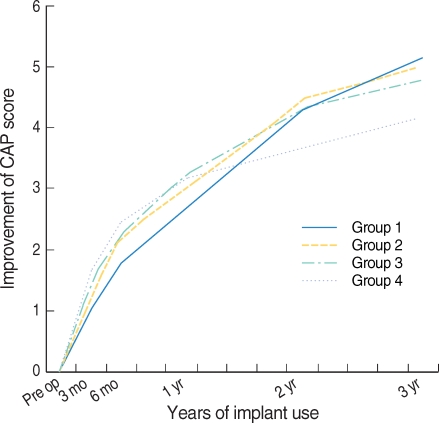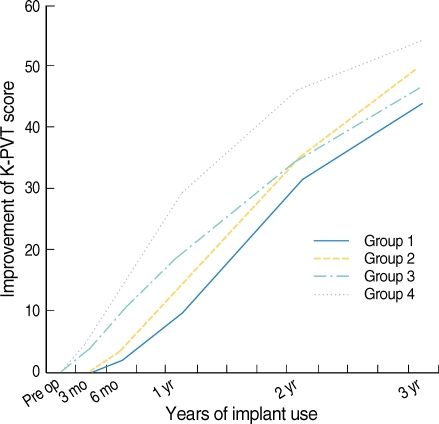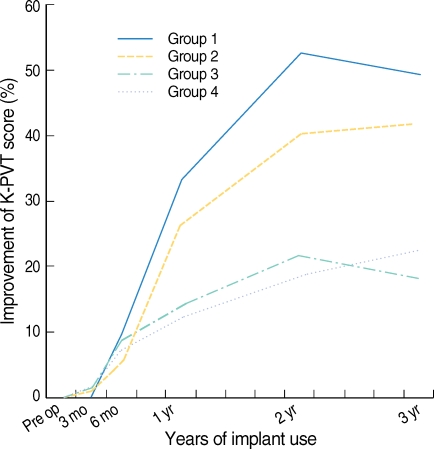Clin Exp Otorhinolaryngol.
2009 Sep;2(3):120-125.
Long Term Outcomes of Early Cochlear Implantation in Korea
- Affiliations
-
- 1Department of Otolaryngology-Head and Neck Surgery, Dankook University, College of Medicine, Cheonan, Korea.
- 2Speech and Hearing Clinic, Seoul National University Hospital, Seoul, Korea.
- 3Department of Otorhinolaryngology, College of Medicine and Research Center for Sensory Organs, Medical Research Center, Seoul National University, Seoul, Korea. shaoh@snu.ac.kr
Abstract
OBJECTIVES
The objective of this study was to compare the long-term auditory performance and language skill depending on the age of cochlear implantation in the Korean population. We especially tried to separate the effect of maturation/development from that of the age at implantation. METHODS: Eighty-six pre-lingual children with profound hearing loss who underwent a cochlear implantation before the age of six and had been followed for more than 3 yr were included in this study prospectively. Categories of Auditory Performance (CAP) and Korean Picture Vocabulary Test (K-PVT) were serially followed up. In order to separate the age at implantation effect, K-PVT results were readjusted to the child's chronological age in the normal hearing population. RESULTS: When the CAP and K-PVT scores were directly compared without chronological readjustment, we failed to show a significant difference for improvements according to the age at implantation. Early cochlear implantation was associated with better language development, only when the K-PVT scores were readjusted to percentile scores of their chronological age. CONCLUSION: Early cochlear implantation was associated with better language development even within the critical period. This advantage may be recognized only when the effect of the age at implantation is separated from the effect of maturation/development.
Keyword
MeSH Terms
Figure
Reference
-
1. Cho EK, Park HY, Kim JW, Hah JH, Kim CS. Factors influencing speech perception abilities in cochlear-implanted children. Adv Otorhinolaryngol. 2000; 57:145–147. PMID: 11892130.
Article2. Baumgartner WD, Pok SM, Egelierler B, Franz P, Gstoettner W, Hamzavi J. The role of age in pediatric cochlear implantation. Int J Pediatr Otorhinolaryngol. 2002; 2. 62(3):223–228. PMID: 11852125.
Article3. Cheng AK, Grant GD, Niparko JK. Meta-analysis of pediatric cochlear implant literature. Ann Otol Rhinol Laryngol Suppl. 1999; 4. 177:124–128. PMID: 10214816.4. Geers AE. Speech, language, and reading skills after early cochlear implantation. Arch Otolaryngol Head Neck Surg. 2004; 5. 130(5):634–638. PMID: 15148189.
Article5. Kileny PR, Zwolan TA, Ashbaugh C. The influence of age at implantation on performance with a cochlear implant in children. Otol Neurotol. 2001; 1. 22(1):42–46. PMID: 11314714.6. Manrique M, Cervera-Paz FJ, Huarte A, Molina M. Advantages of cochlear implantation in prelingual deaf children before 2 years of age when compared with later implantation. Laryngoscope. 2004; 8. 114(8):1462–1469. PMID: 15280727.
Article7. Zwolan TA, Ashbaugh CM, Alarfaj A, Kileny PR, Arts HA, El-Kashlan HK, et al. Pediatric cochlear implant patient performance as a function of age at implantation. Otol Neurotol. 2004; 3. 25(2):112–120. PMID: 15021769.
Article8. Lee DS, Lee JS, Oh SH, Kim SK, Kim JW, Chung JK, et al. Cross-modal plasticity and cochlear implants. Nature. 2001; 1. 409(6817):149–150. PMID: 11196628.
Article9. Oh SH, Kim CS, Kang EJ, Lee DS, Lee HJ, Chang SO, et al. Speech perception after cochlear implantation over a 4-year time period. Acta Otolaryngol. 2003; 1. 123(2):148–153. PMID: 12701730.
Article10. Fryauf-Bertschy H, Tyler RS, Kelsay DM, Gantz BJ, Woodworth GG. Cochlear implant use by prelingually deafened children: the influences of age at implant and length of device use. J Speech Lang Hear Res. 1997; 2. 40(1):183–199. PMID: 9113869.11. Papsin BC, Gysin C, Picton N, Nedzelski J, Harrison RV. Speech perception outcome measures in prelingually deaf children up to four years after cochlear implantation. Ann Otol Rhinol Laryngol Suppl. 2000; 12. 185:38–42. PMID: 11140997.
Article12. Kirk KI, Miyamoto RT, Lento CL, Ying E, O'Neill T, Fears B. Effects of age at implantation in young children. Ann Otol Rhinol Laryngol Suppl. 2002; 5. 189:69–73. PMID: 12018353.
Article13. Miyamoto RT, Kirk KI, Svirsky MA, Sehgal ST. Communication skills in pediatric cochlear implant recipients. Acta Otolaryngol. 1999; 3. 119(2):219–224. PMID: 10320080.14. Papsin BC. Cochlear implantation in children with anomalous cochleovestibular anatomy. Laryngoscope. 2005; 1. 115(1 Pt 2):Suppl 106. 1–26. PMID: 15626926.
Article15. Archbold S, Lutman ME, Marshall DH. Categories of auditory performance. Ann Otol Rhinol Laryngol Suppl. 1995; 9. 166:312–314. PMID: 7668685.16. Archbold S, Lutman ME, Nikolopoulos T. Categories of auditory performance: inter-user reliability. Br J Audiol. 1998; 2. 32(1):7–12. PMID: 9643302.
Article17. Kim YT, Chang HS, Im SS, Baek HJ. Picture vocabulary test. 1995. Seoul: Seoul Community Rebabilitation Center.18. Dunn LM, Dunn DM. Peabody picture vocabulary test-revised. 1981. Circle Pines, MN: American Guidance Service.19. Govaerts PJ, De Beukelaer C, Daemers K, De Ceulaer G, Yperman M, Somers T, et al. Outcome of cochlear implantation at different ages from 0 to 6 years. Otol Neurotol. 2002; 11. 23(6):885–890. PMID: 12438851.
Article20. Lenarz T, Lesinski-Schiedat A, von der Haar-Heise S, Illg A, Bertram B, Battmer RD. Cochlear implantation in children under the age of two: the MHH experience with the CLARION cochlear implant. Medizinische Hochschule Hannover. Ann Otol Rhinol Laryngol Suppl. 1999; 4. 177:44–49. PMID: 10214801.21. Serry TA, Blamey PJ. A 4-year investigation into phonetic inventory development in young cochlear implant users. J Speech Lang Hear Res. 1999; 2. 42(1):141–154. PMID: 10025550.
Article22. Waltzman SB, Cohen NL. Cochlear implantation in children younger than 2 years old. Am J Otol. 1998; 3. 19(2):158–162. PMID: 9520051.
- Full Text Links
- Actions
-
Cited
- CITED
-
- Close
- Share
- Similar articles
-
- Language Development in Profoundly Prelingually Deaf Children with Cochlear Implantation: Long-Term Outcomes
- Cochlear Implantation
- Balance Problem after Cochlear Implantation
- Auditory Rehabilitation - Cochlear Implantation
- Cochlear Implant Failure due to Cochlear Nerve Deficiency in a Child with Normal Internal Auditory Canal




